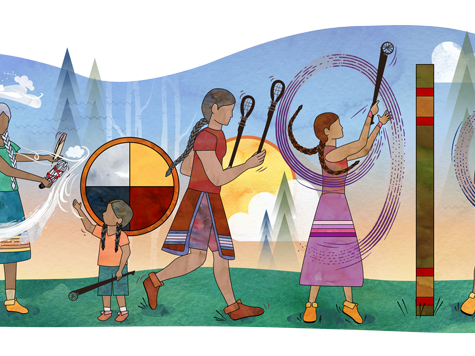Section Branding
Header Content
See Google's logo transform into a stickball game for Native American Heritage Month
Primary Content
On the first day of Native American Heritage Month, the Saint Paul-based Indigenous artist Marlena Myles reimagined the Google logo to honor the North American Indigenous game of stickball.
In the Nov. 1 Google Doodle, the G is illustrated as an elder performing a pregame ceremony of smudging — burning a substance like sage or tobacco. One "O" is a medicine wheel, a symbol used by many North American tribes, to "illustrate that we are part of a never ending sacred hoop," said Myles, a member of the Spirit Lake Dakota/Mohegan/Muscogee tribe.
In a Q&A with Google, Myles explained the cultural significance of the game.
"It's a healing sport for the whole community," she said. "People aren't just playing to win, but are playing for their community's health. This sport has played an active role through the generations in our many tribes and it will continue to do so."
In the game, players score points when the ball touches their opponent's goal post on either end of a field. But players can't touch the ball with their hands and instead use sticks with a net on the end to pass it closer to the goal.
The sticks in the drawing reference the varied styles of stickball played in different regions. Myles said the Great Lake's sticks are about three feet long and have a circular hoop for the net. In the Southeast, on the other hand, the nets are shaped more like an egg, and some in the area even play a version with two shorter sticks. Lacrosse was derived from the stickball style that's played in what is now known as New England, with a longer stick and oval-shaped hoop.
Stickball's origins go back to as early as 1100 A.D. It's also known as "The Creator's Game," Terry Scott Ketchum, who is Mississippi Choctaw of Oklahoma and part of the Native American Studies department at East Central University in Oklahoma, told KERA's Elizabeth Myong. He said the game is a "way of life" for Indigenous communities.
"Just when you're out in that field and you're playing in a game, it's like you kind of escape from this little colonial world," Hoss Villa, a stickball player with Chichimeca Coahuiltecan Indian ancestry, told Myong. "You're in a place where none of this out here matters, kind of like a time machine. You just go back in time and play."
Myles hopes that her doodle helps show "Native people living in a healthy and modern way, passing on teachings from one generation to the next," she told Google. "We're keeping traditions alive."
Copyright 2022 NPR. To see more, visit https://www.npr.org.

